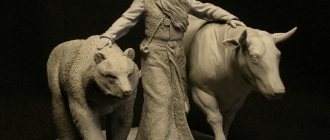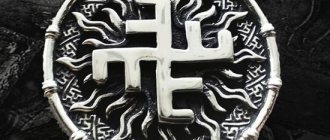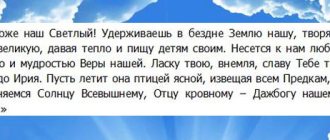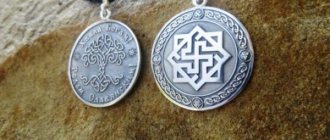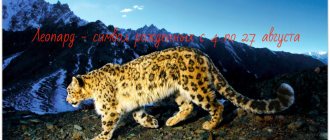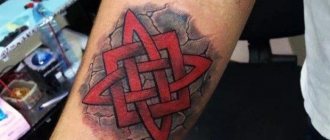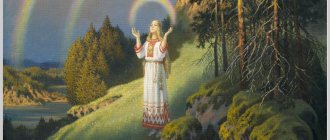The sun is high in the clear and blue sky. It shines brightly and carefree, and that’s why it feels good in the soul, that you just want to sing. People don’t sit in huts, some work in the fields from the very dawn, some hide in the forest, waiting for the beast, some fish on the river bank - all in honest labor. And the work is going well, because everyone’s soul is good. Children run, rush around the village, play their intricate games and enjoy life. How could it be otherwise, because everyone loves the clear sun; from the light, his soul is filled with happiness and love. And I want to live on such a day and do righteous deeds. The people believe that this is the grace of the bright god Khors, descending on them from heaven itself. The Slavs love and honor him, because the solar god works with them, while a man plows the field, Horse echoes him and plows Heavenly Svarga. God is a worker. Khors knows how hard life is for mortal people, so he sends his warmth to people, so that it will be easier for them in all sorts of hardships. And when the sun warms the porch and the threshold, people smile, because they know that God Khors sends greetings to them from heaven itself, and comes to visit everyone.
Slavic god Horse.
Information about this deity is very scarce. There are many contradictions and inaccuracies, but in general terms the god Khors is the solar, that is
solar deity. The reader may quite reasonably have a question regarding this statement, because at least several solar deities are still known: this is Yarilo, and Dazhdbog, and even Semargl. The author agrees that the situation here is very confusing, and it is very difficult to separate one deity from another, because the images and functions of these gods are very blurred and tend to merge with each other. The following explanation of the solarity of the god Khors is very common on the Internet: Yarilo is a god who personifies the spring sun and its life-giving power for all nature; Dazhdbog is the personification of the power of sunlight, which conquers darkness and illuminates the entire world of reality, that is, the so-called “white light”; Khors is yellow sunlight that gives people happiness and joy, and which contributes to their work and the fertility of the earth. There is almost no argumentation as such, but it sounds quite convincing if we remember that Yarilo comes with spring and generally personifies all the recklessness and passion of this time of year, and Dazhdbog fights with dark forces and eternally defeats them. As for the god Semargl, he is the protector and guardian of the heavenly sun. To put it simply, Semargl is a kind of bodyguard for the triad of solar gods - Khors, Yarilo and Dazhdbog.
So, Khors is the god of the bright sun, which gives people a good mood and calls for work. The god Khors was revered as the patron of farmers. The ancient Slavs believed that everything that happened in the Real World found its response in the heavenly abode of the gods. If a man plowed a pore, then the god Khors did the same over him, plowing the infinity of Heavenly Svarga. God Khors sent his bright light to people on a fine day, warmed the earth and called everyone to work. But only the powers of the god Khorsa were not enough to make Mother Cheese Earth fertile, because the sun does not shine without daylight, and the earth must drink rain moisture in order to absorb more solar heat. Therefore, the god Khors was never presented alone; Dazhdbog and Stribog were considered his constant companions.
On the Internet, you can also find another very interesting statement, according to which the god Khors was not only a solar deity, but also the one who brings a higher order to the universe. The change of seasons, the movement of planets and stars allegedly depended on the god Khors. It was believed that he created such a complex order that it was more often perceived as real chaos. God Horse was able to change the world and space around him, and these changes manifested themselves only over time, but were durable even without the intervention and proximity of the deity himself. The world of Prav came under the influence of Khors first of all, and only after the World of Reality, which he visited occasionally. But even the indirect power and influence of Khors found a response in the human world.
How true all these statements are is unknown to either the author or even the most venerable doctors of historical sciences. All we can do is speculate and speculate.
Dark incarnation of the sun god Khorsa
Khors is the god of the sun, without whom winter would be dark and even colder and lifeless. He gave light and warmth during the most difficult time for the ancient Slavs, fought against the winter creatures of the dark world and prevented their actions. However, he also has a dark side.
Black Horse is a deity from the world of Navi. It is he, according to Slavic beliefs, who sends severe frosts, destructive snowstorms and other weather disasters characteristic of the cold season. This deity can send a snow avalanche or freeze a traveler who is delayed on the road.
However, if you believe the legends, the light incarnation of Horse always turns out to be stronger than the dark one. The god of sunlight always defeats his dark counterpart. They turned to him to protect themselves from the Black Horse and his deeds, to save the winter crop and to survive the cold winter.
God Horse - the mystery of the name.
In the name of the god Khorsa, our modern consciousness will highlight the more familiar root “choir”. The gears in our head will immediately start working and several associations will come out: a choir of bunny boys, a round dance and a good one. In general, understanding the twists and turns of the etymology of a word is a very exciting activity. Let's try to trace the connection between the name of the deity and the words we now know, and you will be amazed at how interconnected everything is.
The most common version about the origin of the name of the god Khorsa is the version according to which the ancient Slavs borrowed this deity from the ancient Iranian peoples. Referring to this version, it can be assumed that the name of the god Khorsa is related to the Middle Avestan “Hvarə Xšaētəm”, with the Pahlavi “Xvaršêt”, Persian “Xuršēt” and the Ossetian word “Khur”. The meaning of all these words invariably refers to the word “sun”. According to this theory, the ancient Slavs received this deity as a result of Sarmatian (Turkic) influence. Dating this period is an impossible task for scientists. Some cite the fact that the Slavic and Iranian peoples had common ancestors, Indo-Europeans and Aryans. Then, it can be assumed that the ancient Slavs did not borrow anything, and Horse is one of the most ancient deities, the image of which found a place in paganism of both the Iranian and Slavic peoples.
There is an opinion that the name of the god Khorsa has Slavic roots, and it comes from the word “horo”, which means circle. This is where the word round dance comes from, that is, dancing in a circle. This root also has a modified synonym - “kolo”, from which the words wheel, kolovrat, and so on came. In general, in Slavic mythology, existence has a cyclical, circular character: the seasons replace each other, day and night, life and death. This is how the ancient Slavs imagined the cycle of the universe. If we recall the proposition that the god Horse was supposedly in charge of order in the universe, then this theory does not seem so hopeless. “Horo” or “kolo” is a sacred circle that sets everything that exists in eternal motion: planets, stars, and time. If you remember, the ancient Slavs, and not only them, danced around a fire, and a fire is a flame, a symbol of the Sun. This is both purification and an imitation of the cycle of existence.
Let's look at the root itself “horo”, or “choir”. This is a connection of two particles “Ho” and “Pb”, which means a connection, a unification of force. This is both the concentration of divine, creative power, and its reproduction. “Chorus” is not just a sound, but also a multiple action, where the flows of forces merge into a single whole, almost like in a choir, where the voices of many people merge into a single sound and generate the energy of sound. The root itself carries within itself a creative concept; if everything is in its place, there is no gap in unity, then everything is good. An inversion of this root can be considered the root “rokh”, from which the word “rokhlya” comes, which means something that is not united and is subject to destruction.
You will be surprised, but the word temple contains the root “choir”. If we decipher the constituent parts of this word, we will get a combination of three particles - these are “Xb”, “Ra” and “Mb”. This is the place where the concentration and birth of life takes place, the abode of God, if you like. The word “temple”, or “krom”, among the ancient Slavs is the most important place in the entire settlement, for it is a container of light, a place where life-giving power is born. There is true wealth here, which is why over time palaces and richly furnished houses began to be called “mansions”.
From the root “horo” the word “keep” arose. This statement may seem very controversial to some, but in fact, at first there was the word “good thread”, which means to protect, hide, that is, to hide from unwanted and evil influence. What did people bury? First of all, shrines, various kinds of wealth, children and women with the elderly, and finally the bodies of the dead (here, of course, it is worth mentioning that the ancient Slavs burned the bodies of the deceased, but still this action was called funerals, that is, the action of concealment). They buried (in the current version “kept”) what was most significant. All this was done in order to protect from enemies who could desecrate shrines, kill children (continuers of the clan) and old people (bearers of the wisdom of the clan), and desecrate the womb of women (guardians of the clan) with unholy seed. Each word in the Russian language has its own sacred meaning and a continuous connection with the beliefs of our ancestors.
Whether the god Khors came to our ancestors from the Iranians, or whether it was ours, an original Slavic god, is highly controversial. Time has skillfully covered over the centuries the traces of the true origin of this god, but one way or another, the reader has food for thought.
Deity name
The etymology of the deity's name is rooted in the Indo-Aryan and Iranian language groups. Since the god Khors came along with the settlers, his name has a syllable unusual for the archaic Russian language.
Among the studies of the German linguist Max Vasmer, the name “Horse” translated from Aryan meant:
- glory;
- shine;
- greatness;
- royal dignity;
- shine.
These epithets have been repeatedly applied to the deities of the solar circle, which gives us the right to assume the correctness of such a theory.
According to the research of B. A. Rybakov, the Slavic god Horse has an ancient Scythian name. However, this issue is not without certain difficulties. Soviet researcher and archaeologist V.V. Sedov limits the origin of the name to the Scythian-Sarmatian (Iranian) influence on the Antes people during the period of the Chernyakhov culture, limited to the 2nd-4th centuries.
What do we know about the god Horse?
The god Khors was revered by Prince Vladimir Svyatoslavovich himself, who in 980 installed an idol of this god in Kyiv, in his pantheon, next to the idols of Perun, Dazhdbog, Mokosh, Stribog and Semargl. This action is described in detail in The Tale of Bygone Years.
In another historical source, “The Virgin’s Walk through Torment,” the name of the god Khors is mentioned along with the names of Veles, Perun and Troyan. The god Horse is also spoken of in the “Conversation of the Three Saints.” In this historical treatise, Archbishop Basil the Great calls the Slavic god the angel of lightning and the Jew Horse. The very term “Horse-Jew” gave rise to many opinions, according to which the name and image of the deity was adopted from the Khazar garrison, which was located in ancient Kyiv. The majority of the Khazar Kaganate professed Judaism, hence the assumption why Khors was considered a Jew, that is, a Jew (Jew). In the same treatise, along with the Jew Khors, the Hellenic Perun was also named the angel of lightning. It should not be confused with the Greco-Hellenes, it’s just that earlier, in Ancient Rus', this was what the pagans were called, and for Russian Christian clergy all the pagans and their gods were one and the same. In this treatise, according to the conviction of Viljo Mansikka, Perun meant the Greek Apollo, and Khors meant Nahor, a Jewish character of the Old Testament.
In “The Tale of Igor’s Campaign,” it is said that Vseslav Bryachislavich, allegedly turning into a wolf, traveled from Kyiv itself to Tmutarakan, the night before Khors began his journey. Interpretations and translations of this passage from the treatise are highly controversial and divergent. Some researchers suggest that the original source refers to the city of Kherson, or Korsun.
Mentions of the god Khorsa can be found in other sources. For example, “About the idols of Vladimirov”, “The Word of a certain Lover of Christ”, “Memory and Praise to Vladimir” and much more.
The role of the god Horse in the pantheon
According to the collected data of B. A. Rybakov, the god Horse came to the Slavic pantheon with the Rus tribes. With their arrival, this deity became popular in the lands along the banks of the Dnieper. The Slavic god Horse was part of the pantheon of Prince Vladimir, his idol was installed on the right hand of Perun.
Horse, the god of the Slavs, was one of the incarnations of the sun. Among the three solar brothers, he was credited with the role of director of the movement of the luminary. In terms of seniority, Dazhdbog comes first, then Khors after him Yarila.
Our Slavic ancestors believed that, despite the power of Chernobog, in the winter season the heavenly army, led by Khors, protects the world of Reveal. In the minds of his ancestors, he was a hard worker and a protective warrior.
God Horse and how he was worshiped.
Worship and celebrations of the god Khorsu were celebrated between the winter and spring solstice. This occurred from December 22 to March 21. The beginning of the new year in Ancient Rus' was celebrated on December 22. At this time, according to legend, a new, small sun was born - Khors, who in the first days of winter was weak and did not have enough strength to fully ripen Mother Earth. But with the onset of each day, Horse's power grew, and the evil and cold darkness retreated. Thus, according to this version, Khors was the god of the winter sun. This is a very controversial statement, since on the Internet you can find statements that allegedly Horse was the personification of the autumn sun, and winter Kolyada.
According to some beliefs, the day of the god Khorsa fell on the summer solstice. On the twenty-second of June, when the day is a full sixteen hours long, the sun's powers are at its zenith, but after that the day begins to wane, and this symbolizes that darkness is gaining strength. The foundation of these judgments lies in the eternal confrontation between the Skipper-Snake and the god Horse. If you delve a little deeper into history, you will find that it was on June 22 that Napoleon began his aggression against Russia (this war entailed a reshuffle of forces throughout the world), and in 1941, on June 22, the Great Patriotic War began. Quite an impressive coincidence, isn't it?! In the old days, people were afraid of the approach of the shortest night of the year, because sometimes the radiance of the god Khorsa was not enough to overcome evil, and it won. It seems that in the historical dates mentioned above, evil was victorious. If you believe this theory, then on the day of the summer solstice, when people glorified the god Khors, burning wheels, which personified the sun, were lowered from the hills to the river. They danced in circles and sang songs around the fire. Round Easter cakes were brought to the god Khors.
Appearance
God Horse is depicted as a smiling middle-aged man, ruddy from the frost. Dressed in cool, soft-colored clothes: a white shirt with pants and a cloak of a beautiful azure shade.
Although the solar deity is distinguished by a positive disposition and goodwill, he occasionally suffers from bouts of sadness. Their reason is that Horse’s energy is not enough to protect humanity from the evil of Chernobog and his servants, which they create on cold winter evenings. But our Slavic ancestors were confident that in the end the evil forces would definitely be defeated by the good ones.
God Horse and his pedigree.
There are at least two theories about the origin of the god Khorsa. According to the first theory, this deity was the son of the Great Family, and was the brother of the god Veles. The second theory states that the god Khors was born in the union of the god Ra and the goddess Volyn (Mistress of the Ocean). The wife of this Slavic god was Zarya-Zarnitsa, the goddess of the morning dawn. She gave birth to the god Khors two children - a son, Dennitsa (people said that the goddess Zarnitsa conceived and carried a son not from her husband, but from the Moon, with whom the god Khors fought) and a daughter, Radunitsa. Radunitsa became the wife of the god of the winter sun - Kolyada, and she gave birth to a son, Radegast, who is the grandson of the god Khors.
Power and influence
God Horse possessed versatile powers. He not only ascended to heaven, he was served by various forces of nature. By his command, Khors, the god of the Slavs, could calm the storm and turn the blizzard into soft snowfall.
The Slavic god Horse is related to the solar deities. But he had the heavenly winds and heavy cumulus clouds in his power. It brought not only nice sunny days. Thanks to the command of Khors, soft snow covered the winter crops, protecting them from freezing. That is why he was considered the patron of winter wheat and protector of the harvest. This attitude partially included Khors in the pantheon of fertility gods.
Symbolism of the god Khors.
The symbol of the god Khors is the Poloson swastika, which is a cross with the ends bent inward. Movement of this sign
occurs clockwise and symbolizes the constant cycle of life. Poloson is, first of all, a solar wheel that the god Khors rolls across the sky every day. In ancient times, this sign served as a powerful amulet. Swastika Stripes were embroidered on clothes, applied to tools, furniture, dishes and even weapons. The stripes were burned or painted on houses (usually above the threshold). This amulet was intended to protect wearers from the harmful influence of a polluted environment, from various diseases and ailments. The Poloson amulet could be worn by both men and women. At its core, this amulet combined the powers of both principles.
Another symbol of the god Khorsa is the maple tree. It is a symbol of a warm family hearth, love and mutual respect between family members. Charms made from maple helped to balance a person’s hot temper. In the old days, for those who were under the influence of a love and intoxicating potion, leaves or small maple branches were placed under the pillow in order to calm the person’s mind.
According to some statements, the god Khors even had his own rune - Eyvaz (Eyvis). This rune has a very interesting meaning. First of all, Eyvaz personifies the obstacles that have arisen in a person’s life path. This rune is a signal that a person should ask for protection and patronage from the gods. Eyvaz is the rune of patience, perseverance, understanding and change. We must remember that every test and obstacle is a way to accumulate life and spiritual wisdom.
Tuesday is considered to be the day of the god Horse. His element is fire (who would doubt it?!). The island of Joy serves as the night refuge for the god Horse, but with the onset of dawn, the god leaves the island and sets off to wander across the sky. There is information that the god Khors could take the guise of the sacred bird Alkonost.
Four faces of the sun god among the Slavs
The image of the sun can be found everywhere.
On children's drawings, household items, bedding, clothing, amulets. The Slavic sun god has 4 faces or hypostases corresponding to the seasons. Each season the sun represents a different god.
Each has its own character and specific image:
- winter - Horse;
- spring - Yarilo;
- summer - Dazhdbog;
- autumn – Svarog.
The ancient Slavs respected the commandments of each sun god and in honor of each of them there was a day of honor (celebration).
What signs did the people share with the summer solstice?
This is the time when the line between worlds becomes very thin and it is necessary to adhere to some rules and signs.
- If it rains on this day, it means that higher powers are dissatisfied with something.
- A person who was born on such a holiday has the gift of treating people with medicines and herbs.
- At sunrise, you must take a drink of water; it is credited with medicinal properties.
- On the day of the solstice, you need to place nettles at the doorstep of your house, then all misfortunes will bypass your home.
- If a husband and wife, holding hands, jump over the fire on Kupala, then the marriage will be strong and have many children.
- Girls who want to get married need to dance around three fires, then their wish will come true, and they will find a partner in the same year.
- And the most important thing. On the day of the solstice, you need to collect medicinal herbs, make a bouquet of them and hang them in a prominent place at home. This way, all troubles and illnesses will pass through the house.
The sign of the sun in ancient times
In any ancient religion, the sun occupied an important place in human life. It symbolizes the future and the present, life and warmth are associated with it, it is an inexhaustible source of strength and goodness.
Thanks to observing the sun, people learned to predict the future, compiled a calendar, learned to predict the weather and the rampant elements.
Amulets with sun symbols are endowed with colossal protective energy and are available for everyone to wear.
The image of the sun is present in rock paintings, applied to tools, weapons, clothing, and jewelry. The images have a variety of designs, but the sacred meaning is always the same.
The symbol of the sun represents the naturalness and continuity of the flow of time in all cultures of the world. In addition to the general meaning, each culture has its own sacred meaning of solar signs.
